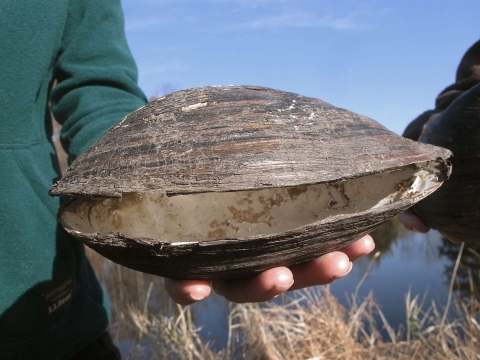A recent video produced by New Jersey Fish and Wildlife tells the story of the invasive silty pond mussel (Sinanodonta woodiana) (also known as Chinese pond mussel) and the collaborative effort in New Jersey to stop its spread. https://www.youtube.com/watch?v=qplXLi5tOPY
Silty pond mussel (SPM) was first detected in North America in 2010 in aquaculture pools in Hunterdon County, New Jersey. SPM is internationally recognized as an invasive species invasive species
An invasive species is any plant or animal that has spread or been introduced into a new area where they are, or could, cause harm to the environment, economy, or human, animal, or plant health. Their unwelcome presence can destroy ecosystems and cost millions of dollars.
Learn more about invasive species with several established populations in Europe, Russia, the Caribbean, and Africa. At high densities, SPM can outcompete native mussels and negatively impact entire aquatic ecosystems. In 2021, USFWS completed an ecological risk screening assessment and determined that the risk category for SPM is high. The aquaculture pools are hydrologically connected to the Wickecheoke Creek, a tributary of the Delaware River. Wickecheoke Creek also connects to the Delaware and Raritan Canal, which crosses the state from Delaware to the Atlantic Ocean and could serve as a significant dispersal vector should the SPM population expand.
An Early Detection, Rapid Response effort has been underway, led by partners at New Jersey Department of Environmental Protection, New Jersey Water Supply Authority, New Jersey Conservation Foundation, Rutgers University, and the Service. The New Jersey Field Office’s Partners for Fish and Wildlife program has been involved in the eradication effort since 2017, and the Environmental Response and Restoration program became involved in the response effort due to potential implications to several planned aquatic connectivity and habitat restoration projects being funded through Natural Resource Damage Assessment and Restoration settlements.
Beginning in 2021, environmental DNA (eDNA) sampling and analyses using a highly sensitive genetic marker developed by Rutgers University was completed to determine if there has been any escape of SPM from the aquaculture pools to other waterways. In 2021 and 2022, a sample taken from the Raritan River at the confluence of the Millstone and Raritan Rivers yielded positive results for SPM, indicating a potential population in the Raritan watershed. In 2024, a follow up eradication treatment effort took place at the origin aquaculture ponds, and SCUBA and snorkel mussel surveys were completed in response to the positive eDNA results in the Raritan watershed as an effort to locate the potential source population of the eDNA. SPM were not readily detected through the survey; however, the project team aims to continue to monitor and prevent the spread of SPM.







